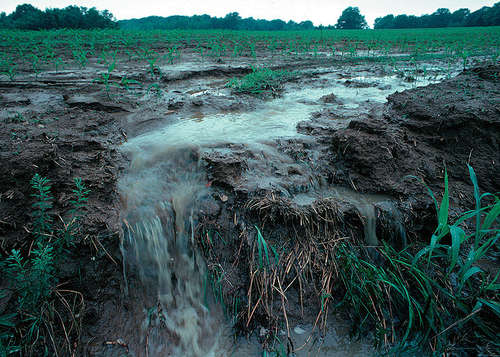South Metro river sediment cleanup plan soon ready for public review

Lake Pepin is filling with excess dirt and soil particles (sediment) from farm fields such as this.
Photo: USDA
As regular Mississippi Messages readers know, Minnesota and Wisconsin have been hard at work developing a clean-up plan to address the excessive sediment pollution in the South Metro portion of the Mississippi River. After years of work, project leaders are preparing to open the plan for public comment one of the final steps before this plan becomes a reality.
Spanning from its confluence with the Minnesota River at Fort Snelling to Lake Pepin near Red Wing, the South Metro section of the Mississippi River is clogged with dirt and soil particles (sediment) that harm aquatic life and recreation along the river. This sediment is also filling in Lake Pepin, the upper third of which will be gone before the end of this century unless action is taken. The Minnesota Pollution Control Agency (MPCA), along with the Wisconsin DNR, Stakeholder Advisory Committee members and key representatives from universities and research groups, has spent several years developing pollution cleanup goals for each of the major tributaries and pollution sources to the South Metro Mississippi River. These goals are at the heart of the MPCAs cleanup plan.
The cleanup plan called a TMDL (Total Maximum Daily Load) includes pollution reduction goals specific to each of the major watersheds that drain to the Mississippi River. The MPCA recommends the following reductions in the amounts of sediment flowing into the Mississippi:
- 60% from the Minnesota River during high and very high flows and 50% during average and low flows;
- 50% from the Cannon River;
- 20% from the Upper Mississippi River;
- 25% from urban runoff; and
- 20% from smaller tributary rivers and streams in Minnesota and Wisconsin.
In addition, the MPCA and local partners are planning for changes within the river itself, such as temporarily lowering water levels to jump-start the growth of important aquatic vegetation, bottom-dwelling plants.
When these pollution goals are achieved, aquatic vegetation in the river would roughly double, and the overall health and vitality of the rivers ecology would greatly improve. In addition, the expected lifespan of Lake Pepin would nearly double.
How you can help
The MPCA has indicated its plans to release the Draft South Metro Mississippi River Sediment TMDL for public comment in early November. After a proposed 45-day public comment period, the MPCA will respond to comments, adjust the Draft TMDL accordingly, and present the plan to the MPCA board for final approval this winter.
FMR members can help move this project forward by offering comments in support of the state's cleanup efforts. Look for a special FMR announcement, complete with comment guidelines, sample comments and additional information, in the coming weeks. We hope you will take the opportunity to let your voice be heard on this important project.
For more information:
- Learn more about the South Metro Mississippi Turbidity TMDL.
- The Minnesota Pollution Control Agencys website on the TMDL is a great place to start.
- For a quick but solid overview, download the MPCAs four-page PDF Fact Sheet.
- The full cleanup plan is also available on the MPCA's site.
- Additional FMR background materials:
- Learn more about TMDLs and The CleanWater Act at FMRs Clean Water Act 101
- Contact FMRs Watershed Program Director Trevor Russell at 651-222-2193 x18 or via our contact form to learn more about FMRs role in the south metro turbidity standard and how you can further be involved.